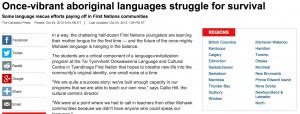After doing the readings for Module 1 and learning about the importance of place, and based on the experience I have working and living in a Cree Community for a bit over three years, I am interested in the programs and opportunities that introduce, use and promote media and technology, not just in K-11 education, but in various aspects of community life.
I wanted to include N’we Jinan, because they have a big presence in the community I live in. They have visited my school and created music videos with our students. The writing, production and filming processes are truly amazing! However, others have already mentioned the program, so I will leave it out.
1. Minority Media
Minority Media is a company based in Montreal that creates virtual reality games. They have focused on introducing a new type of video game genre: empathy games. In 2014, they released Spirits of Spring, a game that centers on a young boy, Chiwatin, and his friends in Northern Canada who are trying to come to terms with bullying.
Minority Media also created a virtual reality game for the Cree School Board to help young students learn Cree Syllabics. With the help of a girl named Niipiish and her dog, students learn new words in a really exciting way. I’ve played this game and watched my students use it. It is a very interesting way for them to practice their language.
2. Mikw Chiyâm
Mikw Chiyâm is an arts program with the goal of increasing student retention and engagement. Professional Canadian Indigenous and non-Indigenous artists are in residency at an appointed CSB school for a 7 week program. There are four residency cycles per school year, which allows the students to be exposed to a variety of artistic forms. They collaborate with local artists and students to help them express their voices creatively. While this program is not explicitly about technology, certain of the artists-in-residence have this as their specialty and incorporate it into the program in various ways.
3. Aanischaaukamikw Cree Cultural Institute
The Cree Cultural Institute is a museum with information and artefacts aimed at preserving and passing on Cree traditions, knowledge and values. Almost everything is accessible through the website. Visitors can virtually explore categories such as hide and fur preparation, moccasins and mittens, and snowshoes and toboggans. There are descriptions, images and even videos. There are also different zones, such as The Community’s Way of Life and The Land Has Memory. The museum even has an app!
The Nation is an independent Aboriginal news publication that covers and reports on stories about and impacting residents of the James Bay area in northern Quebec and Ontario. In addition to news and events, The Nation website also has an extensive list of Cree Legends, available in both English and Cree.
5. EIJBRG
Eeyou Istchee James Bay Regional Government website provides a wide range of information about this region, such as a brief history, the territory and their services. The publish reports on important issues such as drinking water, as well as news. The website also live streams events, such as elections and council meetings.

